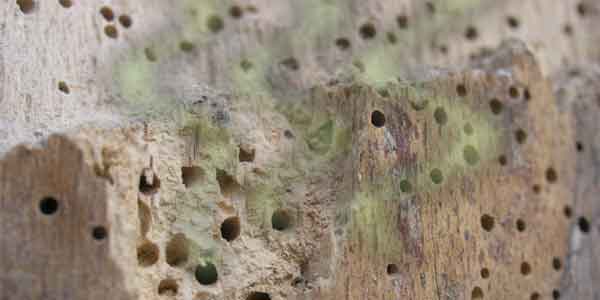A bug infestation in your home, such as woodworm can be distressing. It can even make you feel that your property is unclean. One thing that can make a woodworm infestation even worse, is you might notice an odour at the same time.
It’s common to associate infestations with certain odours. This is because certain smells can be present when you have woodworm.
The idea of having woodworm is enough to leave you feeling uneasy, but an unpleasant smell can make this even worse. So, does woodworm smell?
The good news is that woodworm doesn’t smell. However, there is some bad news. If you do notice an odour at the same time, it is usually caused by damp. Damp doesn’t just cause damage in your property, but it can also leave an unpleasant, musty smell. In some cases, this has even been likened to cat urine.

Unfortunately, this means that you may have two issues to tackle – woodworm and damp.
Are Woodworm Attracted to Damp?
It’s a common belief that damp attracts woodworm. While this is true, it’s not always the case.
There are several different species of woodworm, and they all have different characteristics. You have those that prefer hardwood and those that prefer softwood. There are also species that are quite happy in dry timbers. Then there are species, such as the Deathwatch Beetle, that are very fond of wood affected by damp.
Woodworm can attack all kinds of wood. This means that they’re not naturally attracted to damp timber alone. Despite this, damp wood can be easier for them to attack. The extra moisture can help create the perfect environment for them to thrive.
Damp timber becomes softer and easier for them to chew, giving them easy access to food. The higher moisture content will encourage woodworm to breed. This can speed up the process and cause them to spread faster.
When damp remains untreated, it can become a serious issue. Furthermore, as damp spreads, it can cause your woodworm infestation to spread with it. As damp and woodworm work together, they attack your timber, causing lots of damage at the same time.
So, woodworm can be attracted to damp wood. Even woodworm that prefers hardwood might attack a softer, damp timber. This proves the importance of dealing with damp as soon as possible.
Will Fixing Damp Stop Woodworm?
So, it’s important to assume that damp attracts woodworm. Taking this approach, you’ll need to consider how the two complement each other. Damp may have attracted your woodworm infestation. Perhaps the woodworm infestation was there before damp started. Whatever the reason, fixing damp will help.
Damp can encourage woodworm to thrive and breed. So, dealing with the problem makes sense as this will enable you to solve several issues at the same time.
If you have damp and woodworm present, you should stop damp immediately. While damp is present, woodworm will continue to breed because they thrive on moisture. The cause of damp could be down to:
- Excess moisture from cooking, showering and drying clothes
- Poor ventilation can lead to condensation as warm air holds moisture.
- Faulty pipes
- Damaged seals around baths and showers
- Penetrating damp
- Rising damp
The list of potential damp causes is extensive. So, it is very important that you find the root cause and try to fix it. This could involve simple DIY damp proofing. Alternatively, it could need more extensive work, that’s requires help from a professional damp proofing company.
The good news is, if you do manage remove the moist conditions, you’re less likely to attract woodworm back.
Therefore, before you take action to remove woodworm, you should focus on stopping damp. If you target the woodworm infestation before damp, they could be attracted back to your damp timbers.
Get Rid of Damp Smells and Woodworm
The odour can usually be removed by taking the correct steps to get rid of damp. Once damp is removed and the area is completely dried, the smell should disappear. This may take some time and you may need to replace affected areas, such as carpets, woodwork, décor.
After the cause of damp has been fixed you can focus on the woodworm. Once a woodworm infestation has been found, you can act to remove and eliminate them. There are several options available to achieve this.
Surface treatments can be applied to the surface of affected timber. This can be sprayed or brushed onto the surface. One popular option is a high-quality boron-based pesticides. This treatment soaks into the surface, killing the infestation. These are available as a DIY solution.
There are also other good DIY solutions sold online. These can be found on sites like Amazon. You can see one of the most popular choices and read reviews by clicking here
In some cases, an Infestation can be too large to treat yourself. Delicate wood may also require professional treatment to prevent further damage. Professionals will use an array of treatments. Water-based treatments will soak into the timber to treat and prevent woodworm.
Fogging treatments are also available. These are often applied under flooring and floorboards. Where infestations have spread across an entire area. In worst case scenarios complete fumigation might be required.
Conclusion
On its own woodworm doesn’t smell. If there is an odour, then it is far more likely to be cause by damp and mould.
It’s possible that damp can attract woodworm. Excess moisture and damp can encourage them to breed. It can also make timber more appealing to certain species, as it becomes easier to eat.
While damp doesn’t always cause woodworm infestations, it can certainly increase their chances.
When you tackle damp, it is very likely that you will be able to remove the damp odour. Plus, this will also help to reduce the chances of woodworm returning.



